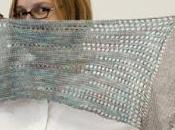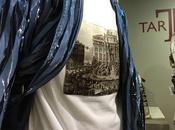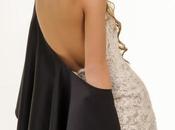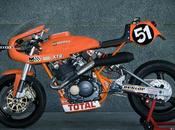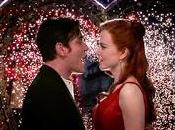
Difficile dover scegliere fra le mille stupefacenti opere di questo eccelso pittore, Francisco Goya, autore che si formo nel Romanticismo ma fu precursore di uno stile completamente innovativo, reale, crudo e angoscioso, ben distante dalla perfezione chi sino ad allora il mondo dell'arte aveva voluto sulle tele degli artisti. Dapprima celebre autore di dipinti raffinati e tecnicamente perfetti, complice i suoi ritratti e suoi lavori come incisionista e quelli commissionati dalla Chiesa e dai Monarchi, nel periodo ultimo della sua attività, egli si dedica a Las pinturas negras, una serie di dipinti ispirati a soggetti malefici: streghe, fantasmi, mostri ed esorcismi utilizzati per sviscerare la sua inquietudine interiore e per significare quanto la natura mostruosa dell'uomo sia vicini a questi elementi.
I colori predominanti delle "Streghe in aria" del 1798, sono cupi e sporchi, con qualche rara traccia di rosso ed ocra mentre i tratti sono rapidi ed essenziali. Il pittore dipinse questa serie interamente di notte rinchiuso nella claustrofobia della sua abitazione in periferia di Madrid, dove si trasferì in seguito alla restaurazione del regime borbonico nel 1819.
Nella tela tre streghe dai lunghi copricapo levitano in aria nel cielo notturno mentre stringono una vittima che cerca di ribellarsi ai loro feroci morsi. Al di sotto, si distingue la figura di un uomo coperto da un telo che gesticola come per allontanare il male da sé, una sorta di gesto scaramantico contro la maledizione.
Il contenuto del dipinto appare prettamente allegorico e ben lontano dalla realtà. Non vi è la presenza di luce o del cielo e non vi sono elementi atmosferici che possano ricondurre il tutto ad un evento tangibile. Il movimento che si percepisce è meramente ristretto agli abiti delle streghe che si sollevano in volo e dell'uomo che cerca di fuggirle. Un altro soggetto sul terreno si copre le orecchie ed ha il capo rivolto verso il basso, per non assistere alla scena. Secondo alcuni critici, l'uomo in preda alle streghe altro non è che il Doppelgänger dei due uomini, ovvero una doppia proiezione, il loro fantasma, la paura bilocata sulle le loro teste.
L'interpretazione più plausibile è l'associazione delle figure allo Stato Spagnolo in preda ad una politica in dissesto e degli uomini della Chiesa imprigionati in un'onta di paura dell'occulto da un lato, di vizio e peccato dall'altro. La figura oscura dell'asino sulla destra, inerme e inconsapevole di quanto stia accadendo, può forse voler personificare l'impotenza umana e l'inadeguatezza di fronte ad un momento di caos. Un dipinto incredibilmente complicato da illustrare e sicuramente carico, se pur nella sua apparentemente concisa rappresentazione di messaggi e contenuti latenti, non visibili a tutti. Uno dei motivi per cui l'arte di Goya è e rimarrà una delle più affascinanti di tutti i tempi.
Difficult to choose between many amazing works of this sublime painter, Francisco Goya, an artist who was formed in Romanticism but he was the forerunner of a new style, real, raw and painful, far away from perfection who until then the art world wanted on the artists canvases.
At first, the famous author of paintings refined and technically perfect, thanks to his portraits and his work commissioned by the Church and monarchs, in the last period of his activity, he devoted himself to "Las pinturas Negras" , a series of paintings inspired by evil subjects : witches, ghosts, monsters and exorcisms used for exposing his inner restlessness and mean how the monstrous nature of man was close to these elements.
The predominant colors of the " Witches in the air" in 1798, are dark and dirty, with rare trace of red and ocher; strokes are quick and simple. The artist painted this series entirely at night locked in the claustrophobia of his house in the outskirts of Madrid, where he moved after the restoration of the Bourbon regime in 1819.
In the canvas three witches with long hats levitate in the air in the night sky while shaking a victim who tries to rebel against their ferocious bites. Below, it stands the figure of a man covered with a cloth gesturing as if to ward off evil from himself, a sort of superstitious gesture against the curse.
The content of the painting is purely allegorical and far from reality. There is not the presence of light or the sky and there are not elements that can bring the whole thing to a tangible event. The movement is merely restricted to clothing of witches that are raised in the air and the man who tries to flee them. Another subject on the ground covers his ears and his head facing down, not to witness the scene. According to some critics, the man in the grip witch is nothing but the Doppelgänger of the two men, or a double projection, their ghost or fear bilocated on their heads.
The most plausible interpretation is the association of the figures to the Spanish State in the throes of a political instability and the men of the Church imprisoned in fear of the occult on the one hand, of vice and sin on the other. The shadowy figure of the donkey on the right, defenseless and unaware of what is happening, it may perhaps want to personify the human helplessness and inadequacy in that moment of chaos. A painting incredibly complicated to explain and certainly load , though apparently in his concise representation of messages and latent contents are not visible at all. One of the reasons why the Goya art is and will remain one of the most fascinating of all times.
